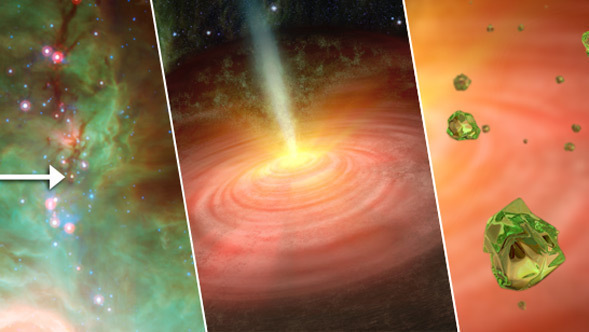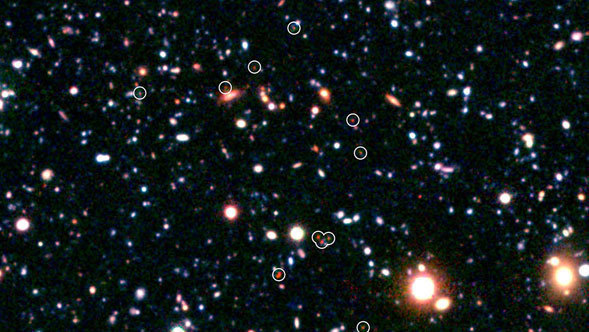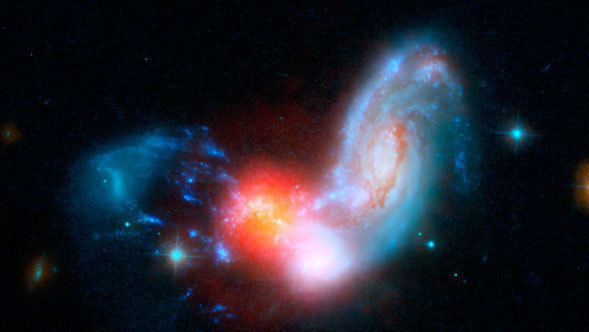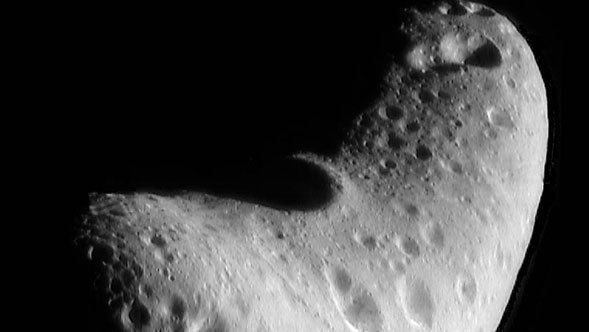Displaying news 241 - 270 of 587 in total
NASA's Spitzer Space Telescope has detected signs of icy bodies raining down in an alien solar system.
NASA's Spitzer Space Telescope has gathered surprising new details about a supersized and superheated version of Earth called 55 Cancri e. According to Spitzer data, the exoplanet is less dense than previously thought, a finding which profoundly changes the portrait of this exotic world.
Flat flakes of carbon have been tentatively spotted in space.
What do you see when you look at this strange mix of shapes from space?
Spitzer scientists and engineers are beginning tests to study the feasibility of switching to the spacecraft's Inertial Reference Unit 2.
Stars appear to be caught in a galactic web in this new image from NASA's Spitzer Space Telescope.
Galaxies once thought of as voracious tigers are more like grazing cows, according to a new study using NASA's Spitzer Space Telescope.
Has the comic book superhero Green Lantern lost his ring? In fact, this giant ring of glowing dust, imaged by NASA's Spitzer Space Telescope, belongs to the cosmos.
Tiny crystals of a green mineral called olivine are falling down like rain on a burgeoning star, according to observations from NASA's Spitzer Space Telescope.
Harvard-Smithsonian Center for Astrophysics
A new planetary member of the Kepler-10 solar system was announced today. Using data from NASA's Spitzer Space Telescope, members of the Kepler science team confirmed a new planet, dubbed Kepler-10c.
NASA's Spitzer Space Telescope has been awarded the prestigious 2011 Stellar Award by the Rotary National Award for Space Achievement Foundation, which recognizes missions whose accomplishments hold the greatest promise for furthering future activities in space.
Astronomers have uncovered one of the earliest galaxies to appear in the distant universe, with stars that formed 13.5 billion years ago, a mere 200 million years after the Big Bang.
Astronomers have discovered that two symmetrical jets shooting away from opposite sides of a blossoming star are experiencing a time delay: knots of gas and dust from one jet blast off four-and-a-half years later than identical knots from the other jet.
Stars at all stages of development, from dusty little tots to young adults, are on display in a new image from NASA's Spitzer Space Telescope.
Twenty five years ago moving vans were being loaded at the Union Bank, on South Lake Avenue in Pasadena, for the first delivery of "stuff" to the new IPAC Building (Morrisroe Astroscience Laboratory).
Astronomers have uncovered a burgeoning galactic metropolis, the most distant known in the early universe. This ancient collection of galaxies presumably grew into a modern galaxy cluster similar to the massive ones seen today.
Astronomers have turned up the first direct proof that "standard candles" used to illuminate the size of the universe, termed Cepheids, shrink in mass, making them not quite as standard as once thought.
Real space science and insights into teaching astronomy come straight from the classroom to a renowned international conference this week. Nearly 60 teachers, students and astronomy educators will be on hand to present the fruits of their year-long labor as participants in NITARP, the NASA/IPAC Teacher Archive Research Program, at the winter meeting of the American Astronomical Society in Seattle, Wash. from Jan. 9 through Jan. 13, 2011.
Astronomers have discovered that a huge, searing-hot planet orbiting another star is loaded with an unusual amount of carbon.
Astronomers have caught sight of an unusual galaxy that has illuminated new details about a celestial "sandbar" connecting two massive islands of galaxies. The research was conducted in part with NASA's Spitzer Space Telescope.
Astronomers using NASA's Spitzer Space Telescope have found a stunning burst of star formation that beams out as much infrared light as an entire galaxy.
Astronomers have discovered bucket loads of buckyballs in space. They used NASA's Spitzer Space Telescope to find the little carbon spheres throughout our Milky Way galaxy -- in the space between stars and around three dying stars.
Fresh after finding buckyballs around an aging star, NASA's Spitzer Space Telescope has now detected these intriguing, miniature-soccer-ball-shaped molecules in interstellar space for the first time.
Observations from NASA's Spitzer Space Telescope reveal a distant planet with a warm spot in the wrong place.
A giant star in a faraway galaxy recently ended its life with a dust-shrouded whimper instead of the more typical bang.
NASA's Spitzer Space Telescope data offers insight into cores of star-forming regions.
New research from NASA's Spitzer Space Telescope reveals that asteroids somewhat near Earth, termed near-Earth objects, are a mixed bunch, with a surprisingly wide array of compositions.
Tight double-star systems might not be the best places for life to spring up, according to a new study using data from NASA's Spitzer Space Telescope. The infrared observatory spotted a surprisingly large amount of dust around three mature, close-orbiting star pairs. Where did the dust come from? Astronomers say it might be the aftermath of tremendous planetary collisions.
Astronomers have experienced the galactic equivalent of discovering pictures of a mild-mannered grandmother partying as a wild youth.
Displaying news 241 - 270 of 587 in total

































